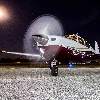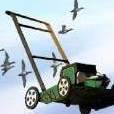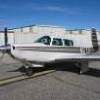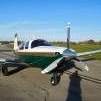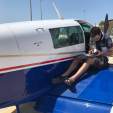Leaderboard
Popular Content
Showing content with the highest reputation on 04/18/2024 in all areas
-
There is a little chain that connects to the trim wheel. The chain can pop off if it isn’t properly lubricated, and when it pops off the wheel will spin freely. Definitely talk to an A&P because you’ll want to rule out a need to lubricate the trim jackscrew. But this might be a 5-minute fix.3 points
-
If it’s the chain, the indicator will move with the electric trim. If it doesn’t, the trim torque tube is disconnected somewhere.2 points
-
Y’all are not true CB’s. I use the packing paper in Spruce boxes to making an oil drain channel. Since the paper isn’t rigid, it is easy to push up under the oil filter. I also usually wait a day to remove the filter. Lee2 points
-
I was playing my daily crossword puzzle and it occurred to me if you rearrange the letters in Mooney C you get economy.2 points
-
Hangarage takes care of most of it. Don’t worry about it. Keep her in a hangar, treat her with Corrosion X or one of the other corrosion treatments every other year, use CamGuard, and try to fly her at least every other week. That really is all you can do, and if you do it she will probably outlast you. I am going on 42 years with ours here in the humid South and so far so good. Actually her first 17 years with her original owner tied down in Teterboro did far more damage.1 point
-
Could you go to a modern HSI and drop an engine monitor in place of one of the old CDI's? Sent from my motorola edge plus 2023 using Tapatalk1 point
-
If the trim position indicator moves when you turn the wheel, the chain and forward gearbox are working. You can easily check the chain by removing the plastic chain cover in the cockpit (three small Phillips screws). If the trim indicator moves with the wheel, then something is disconnected somewhere along the trim shaft. Installing a GFC 500 trim servo requires disconnecting the trim shaft and it’s possible something didn’t get back together correctly. If it’s not the chain or gearbox, check the integrity of all the u-joints along the shaft in the belly and tail. If you can find a problem and fix it, set the trim indicator to takeoff with the wheel and turn the trim shaft so that trim assist bungees hold the elevator in alignment with the stabilizer before connecting everything up.1 point
-
1 point
-
You don't have an intake boot? Your retirement investment strategy is sorely lacking....1 point
-
Swift is actually saying that both peak and LOP are a no no. I read nothing compelling in that BT thread, though there is some reasoned speculation. Lycoming once again seems to be proving that their default position is to make general statements without providing supporting data. There may be a carb issue, but parallel valve Lycomings have always had somewhat more challenging cooling characteristics (flame suit on but Lycoming's cooling charts prove it). If the operators are adhering to the manufacturers CHT limits and recommendations, "mircowelding" should not be an issue. I am also dubious on the idea that detonation sufficient to cause valve recession (not something I've ever heard of) would fail to produce any of the other common issues associated with detonation (cracked spark plug insulators, deformed electrodes, ring and land damage, piston pitting, scuffing etc). Lycoming is suggesting that the recession is caused by aromatics, but 94 UL does not have high concentrations of aromatics (relatively speaking), not to mention that many, many Archers have been running on Mogas (much higher levels of aromatics) for years. The situation is as clear as mud. Hard data would be nice, but I have yet to see any analysis. UND and their propulsion engineering dept. should have been an impartial analyst collecting and analyzing data, but I have not seen evidence that they've done much of that. Maybe this will happen in the future as all aircraft were equipped with Garmin G1000, so they should have the raw data. To do this correctly, they should have had a control group and an exclusively 94UL group of the same aircraft running the same missions and then analyzed each group post trial. Instead they ran 94UL in the whole fleet of eligible aircraft and also mixed 100LL in with 94 UL during the trial (any offsite fueling was 100LL). I have seen no synopsis of engine telemetry from the trial but it looks like they are working on that. Lycoming and Swift are both "interested parties" and both should be sidelined when it comes to analyzing this less than ideal trial.1 point
-
1 point
-
1 point
-
Being that GPS it's single point of failure and not easy serviceable as ground based systems at my understanding. The world strive could cause one of these unstable or rouge nation(s) (north Korea or Iran or some other nation) create havoc on the rest of us if they start launching into space. In 90's I heard something about the I think it was called ALS (Advance Landing System) it made use of already existing equipment in our plane. I think Transponder and CDI as I recalled you were assigned a discrete transponder code and some how it tied in to CDI for course lateral and vertical guidance. I haven't heard to much activity on that topic I think heard mentioned but no real pursuit. I would nice to another low cost back up alternative should the GPS system outage becomes the new norm.1 point
-
No, he said to test the gauge, hook up a 15 ohm resistor to ground is it should read 1/2 tank.1 point
-
That would be neat I think historically, these radial/radial were never coded as official waypoints (or even as internal computational navigation fix, CNF) because they do require “dual magnetic variation” inputs and handling which is not supported in TSO146 (in US, this is moot as VOR magnetic lines are frozen anyway, the better word is “magnetic declination”: original variation at the time the VOR was last aligned or installed) The GPS will naturally handle, VOR-VOR legs and VOR-DME legs on VOR airway as these can be coded as track-to-fix (TF) or along-track-distance (ATD) irrespective of magnetic variation: one flies the true line between two fixes that happen to be VOR… The older GPS TSO129, did not specify which magnetic variation (airport, vor, internal, published…) has to be used to get magnetic course although most of them use VOR published one on VOR radial or tack legs, in TSO146 like GTN, it’s explicit that you need to use the published VOR magnetic variation, however, it’s a issue when you have two VOR radials (it’s theoretical one: they could interpolate or use the closest one and likely it does not matter that much) * Direct-to-VOR+OBS or Course-To-VOR will use published VOR variation or declination * Direct-To-Waypoint use internal magnetic model when it shows magnetic course * Radial/Radial, well you can see a debate with 3 choices to pick from, it seems ForeFlight does solve this quietly and easily behind the scenes for you (*) See 2.2.1.3.12 Magnetic Course, RTCA DO 229D specs for WAAS GPS, it’s a shame we have to pay for this document but here is some info https://www.euroga.org/forums/flying/2784-gnss-approach-availability-in-europe?page=3#post_44004 (*) None of this is relevant or matters in practice, especially, when flying departures or terminal procedures (30nm around airport ARP?), however, someone was concerned about errors on 1000nm radial/radial that cross the North Pole …1 point
-
Butler acquired Mooney when it came out of bankruptcy around 1969 and then Butler also acquired Aerostar and moved production to Kerrville. I think at that point they renamed the company Aerostar and they dropped the Mooney name and all of the airplanes were called Aerostars in 1970 & 1971 and even the "m20" 's had the tails that were shown in the picture. The C's were renamed Aerostar 200, E's were Aerostar 201, and F's were Aerostar 220 Executive. Butler closed the plant in '71 and you won't find a 1972 or 1973 Mooney because they didn't make any. In late '73 Republic Steel bought them and started making 1974 Mooneys. Republic Steel brought Roy LoPresti in and by '77 there was a 201 and by '79 there was a 231.1 point




